-
Paper Information
- Previous Paper
- Paper Submission
-
Journal Information
- About This Journal
- Editorial Board
- Current Issue
- Archive
- Author Guidelines
- Contact Us
International Journal of Library Science
p-ISSN: 2168-488X e-ISSN: 2168-4901
2020; 9(3): 71-75
doi:10.5923/j.library.20200903.03

A Study on the Frequency and Purpose of Use of E-Resources Regarding Level of Awareness of Students in Sardar Vallabhbhai Patel University of Agriculture and Technology
1Department of Agricultural Extension and Communication, Sardar Vallabhbhai Patel University of Agriculture and Technology, Meerut, India
2Department of Agricultural Extension and Rural Development, Botswana University of Agriculture and Natural Resources, Gaborone, Botswana
Correspondence to: Edwin Maitato, Department of Agricultural Extension and Communication, Sardar Vallabhbhai Patel University of Agriculture and Technology, Meerut, India.
| Email: |  |
Copyright © 2020 The Author(s). Published by Scientific & Academic Publishing.
This work is licensed under the Creative Commons Attribution International License (CC BY).
http://creativecommons.org/licenses/by/4.0/

This study investigated the frequency and purpose of use of e-resources in Sardar Vallabhbhai Patel University of Agriculture and Technology. The study similarly investigated the demographic profile of students and their e-resources awareness. Descriptive survey design was used for this study. The purposeful sampling technique was adopted for this study. The sample consists of 120 respondents. The questionnaire was used as an instrument for data collection and 120 questionnaires were distributed. All the questionnaires were duly completed and found usable for the study. Three research objectives were answered and one null hypothesis was tested at significance level of 0.05. The simple percent statistical tool was used to answer the research objectives and Pearson Correlation Coefficient for testing the hypotheses. The study has revealed that the students use e-resources on daily basis with the internet topping at 98.4% followed by e-Books at 85.6%. As for the purpose of use it has been found out that they use e-resources mainly for assignment, classwork and entertainment purposes with research scholars having an upper hand in their use. Moreover results obtained revealed that SVPUA&T students are quite aware of e-resources.
Keywords: Electronic resources, Awareness about electronic resources, Purpose of using electronic resources
Cite this paper: Edwin Maitato, A Study on the Frequency and Purpose of Use of E-Resources Regarding Level of Awareness of Students in Sardar Vallabhbhai Patel University of Agriculture and Technology, International Journal of Library Science, Vol. 9 No. 3, 2020, pp. 71-75. doi: 10.5923/j.library.20200903.03.
Article Outline
1. Introduction
- Information has been passed on from one person to another since ancient times and it was stored in various ways. According to Hawthorne (2008) the historical trail of e-resources began in the mid-1960s, with the introduction of machine readable catalogue which served as a directive tool to information resources, this followed the use of Online Public Access Catalogue and bibliographic databases, these were later improved to the use of information on CD ROM databases in 1980’s.The digitization of information in print media has brought a new concept altogether in all the fields of human life and hence the creation and use of electronic resources commonly known as e-resources (Kenchakkanavar, 2014). Print-based information resources are dynamically clearing a path for information in electronic form (Sharma, 2009). According to International Federation of Libraries Association (2012) e-resources refer to those materials that require computer access, whether through a personal computer, mainframe, or handheld mobile device. They may either be accessed remotely via the internet or locally.
1.1. Objectives of the Study
- 1. To examine the level of awareness of available e-resources in the university.2. To find out the frequency and purpose of use of e-resources by the students.
1.2. Hypothesis
- H0: There is no relationship between SVPUA&T students’ awareness about e-resources and their use of e-resources.
2. Review of Literature
- Mittal and Bala (2013) reported that majority of students know about e-resources, they additionally utilize these assets yet these assets predominantly incorporate e-books, e-journals and e-thesis, which are useful for them in their research work.Akpojotor (2016) reported that in southern Nigeria, post graduate students of library and information science are quite aware and highly use electronic resources, this study also informed that the students are skilled in the use of electronic resources thus suggesting high level of familiarity with e-resource use in the Library.Yebowaah and Plockey (2017) found that there are different ways to get to know about the e-resources some students got to know about the e-resources by getting their information through internal memo from the librarian, through personal interaction with librarians, through friends in the library and through the library.Shaqour and Daher (2010) reported that most first degree students who participated in the research had medium or high use of electronic resources. The research findings indicate that more than one half of the participants had high level of electronic media use and more than one third had moderate level of electronic media use.Tripathi et al (2016) revealed that the respondents even though were aware of the different types of electronic resources available in the university library; their use rate of these resources is low. It was also discovered that a large proportion of the respondents made use of the electronic resources mostly for research, assignment, current awareness, information acquisition, and e-mail and news acquisition.Hoq and Haque (2018) however stated that the acceptability of electronic resources as a study tool is quite high among the students who took part in their survey. Approximately 90% of the respondents believe that e-resources are either extremely or moderately useful for their study.Prabhakar and Rani (2017) found that the frequent use of Facebook, Twitter, and YouTube among others provides alternatives to the use of libraries. This suggests that people may be using e-resources for academic purposes but not directly from libraries.Nisha and Ali (2012) indicated that the main aim of e-resources is for retrieving information regarding research, publishing papers, assignments, presentations, seminars, and largely to update their own knowledge. The major reasons for participants in this study used the e-journals were in support of their research in IIT Delhi (63%).
3. Research Methodology
- Descriptive survey design was used for this study. The purposeful sampling technique was adopted for this study. The sample consisted of 120 respondents. The questionnaire was used as an instrument for data collection and 120 questionnaires were distributed. All the questionnaires were duly completed and found usable for the study. Two research objectives were answered and one null hypothesis was tested at significance level of 0.05. The simple percent statistical tool was used for the research objectives and Pearson Correlation Coefficient for testing the hypotheses.
4. Results and Discussions
4.1. Gender
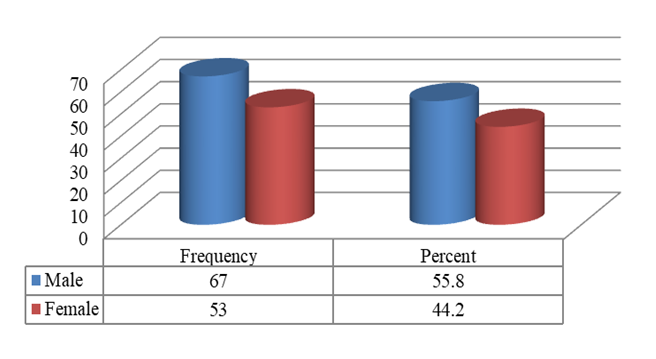 | Figure 1. Distribution of respondents according to their gender |
4.2. Awareness
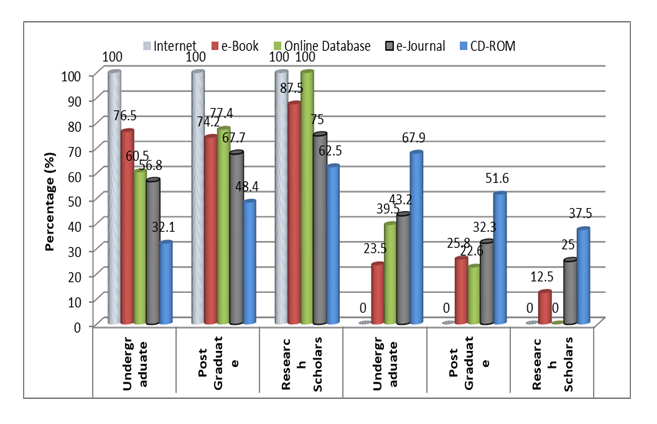 | Figure 2. Distribution of respondents according to their awareness of e-resources |
4.3. Place of Accessing E-Resources
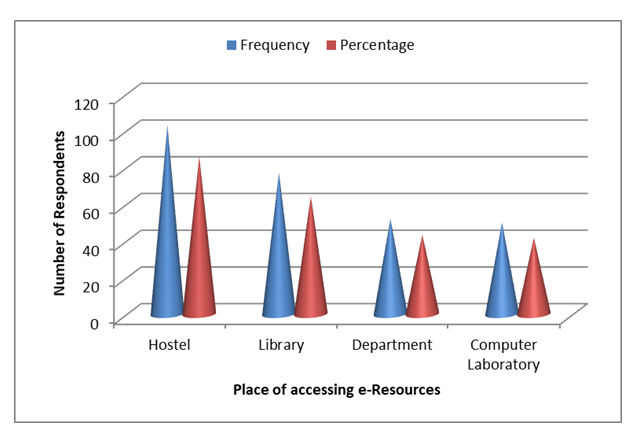 | Figure 3. Distribution of respondents according to their places of accessing e-resources |
4.4. Device for Accessing E-Resources
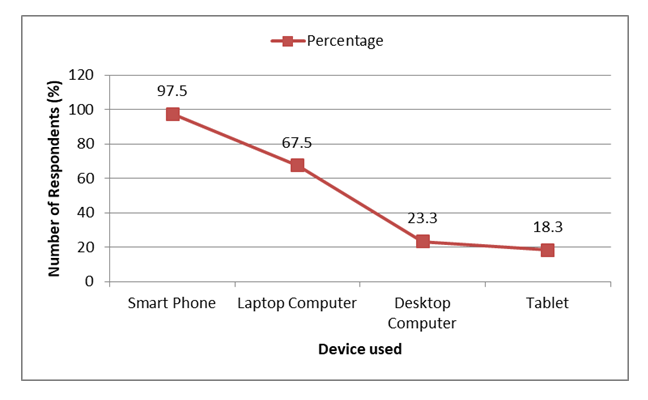 | Figure 4. Distribution of respondents according to their devices used for accessing e-resources |
4.5. Sources of Awareness
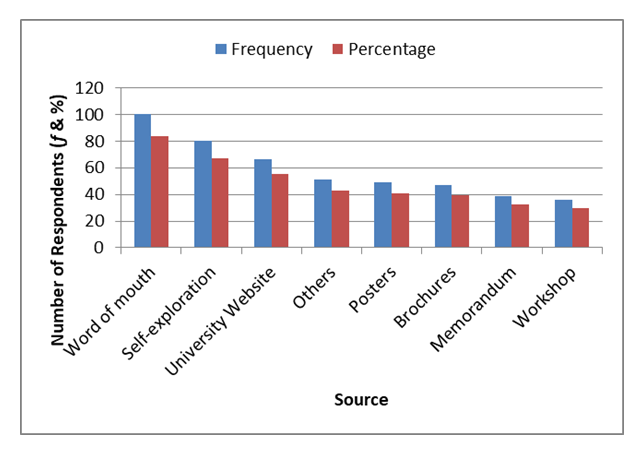 | Figure 5. Distribution of respondents according to their sources of awareness about e-resources |
4.6. Purpose of Use
|
4.7. Frequency of Use
- Table 2 below shows frequency of use of five (5) types of e-resources. Internet is used by 94.2 per cent of respondents daily, 1.7 per cent once a Week, 0.8 per cent Twice a Week, 1.7 per cent Once a Month, and 1.7 per cent never use it. Online Database is used daily by 28.3 per cent, once a week by 19.2 per cent, Twice a Week by 16.7 per cent, Twice a Month by 6.7 per cent and 17.5 per cent never use it. E-Book is used by 19.2 per cent of respondents Daily, once a week by 20 per cent, Twice a Week by 18.3 per cent, once a month by 23.3 per cent, twice a month by 5 per cent and 14.2 per cent never use it. E-journals is used daily by 10.8 per cent of respondents, once a week by 22.5 per cent, twice a week by 9.2 per cent, once a month by 24.2 per cent, twice a month by3.3 per cent whereas 30.0 per cent never use it. CD-ROM is used once a month by 7.5 per cent of respondents, twice a week by 2.4 per cent, once a month by 14.2 per cent, twice a month by 2.5 per cent whereas 73.3 per cent never use CD-ROM. From the information provided by the respondents the Internet is the most frequently used type of e-resource by 98.4 per cent of respondents followed by e-Book with 85.6 per cent of respondents whereas the least used e-Resource is the CD-ROM with 26.7 per cent of respondents. The respondents use e-resources mostly daily followed by once a week, once a month, twice a week, and twice a month.
|
5. Recommendations
- 1. To maintain students’ interest towards e-resources the University must ensure continuous uninterrupted power supply, which can be achieved by backup power systems such as generator and solar power.2. High internet connectivity should be ensured in the university with multiple Wi-Fi hotspots including the students’ hostels.3. Library should be opened during holidays also. It should be 24/7 during examination period.4. There should be creation of awareness among students about the different e-resources.5. Training on use of e-resources should be provided to the students.
6. Conclusions
- The study reveals that males represent the majority (55.5%) whereas females represent the minority (44.2%) of the respondents. In that regard it has been revealed that the respondents are aware of the e-resources especially the internet and e-Books. It also has been concluded that students prefer accessing the e-resources from the comfort of their hostels, using primarily smartphones seconded by laptop computers. With regard to purpose of use it has been found out that students mostly use e-resources for assignments, research purposes and entertainment. The respondents use e-resources mostly on daily basis followed by once a week, once a month, twice a week, and twice a month. The internet is the mostly used e-resource followed by e-Book.
ACKNOWLEDGEMENTS
- My gratitude goes to my supervisors Dr. V.K Singh, Dr. Yogesh Prasad and Dr. Deepak Sisodia for their valuable assistance and my profound appreciation goes to the Head of Department Dr. D.K. Singh who also provided his professional guidance and support. I am also thankful to the University management and all the participators who took part in this research.
 Abstract
Abstract Reference
Reference Full-Text PDF
Full-Text PDF Full-text HTML
Full-text HTML
